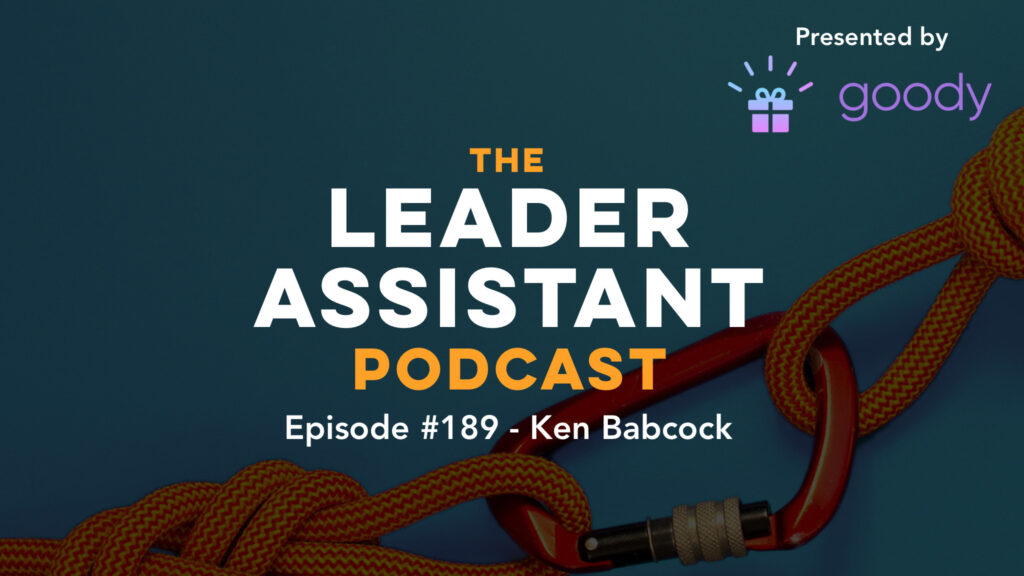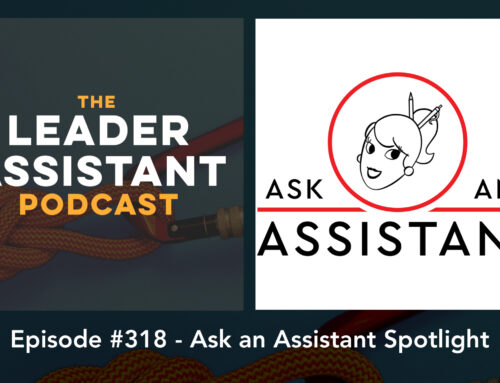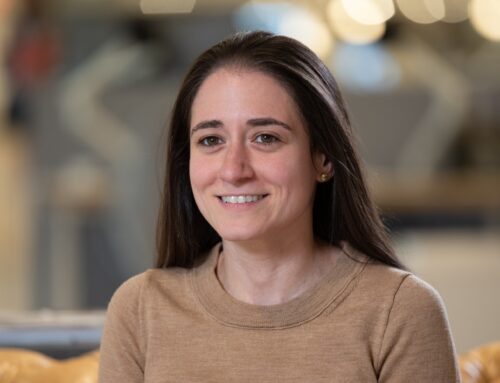Ken Babcock is the Co-founder and CEO of Tango, which allows users to create beautiful step-by-step tutorials of any digital process without the performance art of video recordings.
In this episode of The Leader Assistant Podcast, Ken talks about finding, hiring, and onboarding Tango’s chief of staff, Angela, who was an executive assistant. He shares a bit about how Angela has helped their company and team in a short amount of time.
CONNECT WITH KEN
- Ken on LinkedIn
- Website – tango.us
ABOUT KEN
Ken Babcock is the Co-founder and CEO of Tango, which allows users to create beautiful step-by-step tutorials of any digital process without the performance art of video recordings. Ken, along with his co-founders Brian Shultz and Dan Giovacchini, dropped out of Harvard Business School during the pandemic to start the company.
THE LEADER ASSISTANT PODCAST IS PRESENTED BY GOODY
A special thanks to my sponsor, Goody!
If you send business gifts to employees, clients or sales prospects, Goody is a game changer. You can send one gift or hundreds at the same time, without ever worrying about shipping details. With Goody, your gift recipients provide all their shipping info, and they can even swap out your gift for another option if they prefer. It’s free to start gifting and you get a $20 credit when you sign up. Oh and if you mention you heard about Goody on The Leader Assistant Podcast, Goody will add an extra $10 credit to your account.
Go here to start gifting today!
THE LEADER ASSISTANT PREMIUM MEMBERSHIP
To learn more about how you can join growth-minded Leader Assistants, check out our Leader Assistant Premium Membership for ongoing training, coaching, and community.
THE LEADER ASSISTANT BOOK
Download the first 3 chapters of The Leader Assistant: Four Pillars of Game-Changing Assistant for FREE here or buy it on Amazon or Audible.
LEADER ASSISTANT LIVE EVENTS
Check out our constantly updated schedule of events for admins and assistants at LeaderAssistantLive.com. Including our all-day, online leadership workshop at leaderassistantlive.com/workshop.
JOIN THE FREE COMMUNITY
Join the Leader Assistant Global Community here, or the Facebook Group here for bonus content and to network with other assistants who are committed to becoming leaders!
SUBSCRIBE
Subscribe to The Leader Assistant Podcast so you don’t miss new episodes!
You can find the show on Apple Podcasts, Spotify, Google Podcasts, Pandora, and Stitcher.
Join my email list here if you want to get an email when a new episode goes live.
LEAVE A REVIEW
If you’re enjoying the podcast, please take 2 minutes to rate and review the show on Apple Podcasts here. Each review helps me stay motivated to keep the show going!
—
EPISODE TRANSCRIPT
Podcast Intro 0:05
The Leader Assistant Podcast exists to encourage and challenge assistants to become confident game changing leader assistants
Jeremy Burrows 0:20
The Leader Assistant Podcast is brought to you by goody. If you’re starting to think about holiday gifts for your team like I am, goody is a game changer. They have amazing gifts that people will really love including brands that give back to charitable causes. As a longtime executive assistant, I’ve always been nervous about holiday gifting season. But thankfully, goody’s platform lets you send one gift or hundreds at the same time without ever worrying about shipping details. Can I get an amen? With goody your gift recipients provide all their shipping info, and they can even swap out your gift for another option if they prefer. It’s free to start gifting and you can get a $20 credit when you sign up. Oh, and if you mentioned you heard about goody from The Leader Assistant Podcast goody will add an extra $10 credit to your account. Go to leaderassistant.com/goody to start gifting today. Hey friends, thanks for tuning in to The Leader Assistant Podcast. It’s episode 189. This is your host, Jeremy Burrows. And you can check out the show notes at leaderassistant.com/189 Leaderassistant.com/189 and today I have the privilege of speaking with Ken Babcock. Ken is the CEO of a software company called tango. A trite Tango that’s great name tango.us is their website. Kin how’s it going today?
Ken Babcock 1:54
It’s going good. I’m proud to be number 189. That’s what I was hoping for.
Jeremy Burrows 2:00
There you go. All your dreams have come true. What part of the world are you in?
Ken Babcock 2:05
I’m outside of Chicago. So we are preparing for the impending winter. But yeah, it’s a nice little nice little area of the country. I feel like Chicago is one of those cities where everyone’s like, I’ve never been there. But it’s the number two largest city in the US.
Jeremy Burrows 2:24
Yeah, Chicago is too cold in the winter. That’s for sure. My brother lived there for a while and I’m like, how do you live here in the winter? It’s terrible. But it’s beautiful in the in the summer and spring and fall.
Ken Babcock 2:36
Yeah, summer makes up for it for sure.
Jeremy Burrows 2:40
So tell us a little bit about yourself. Do you have dogs? Do you have kids? Are you a cat person? What are your hobbies? Give us a little bit of tidbits for your personal life.
Ken Babcock 2:50
Yeah, totally. So in Chicago, I live with my, my wife, my nine month old son and our two year old who it all her name is Valpo. If you’re in the Bay Area, we actually named her after a restaurant called del boa cafe. So we used to live in San Francisco. Remember those times very fondly. So we memorialized it with our dog. But yeah, hobbies wise. You know, big, big sports guy. You know biking, tennis, golf, from Buffalo, New York originally. So I’m also a big Buffalo Bills fan, which in the time that I’ve been a Buffalo Bills fan now is definitely the best time to be a Buffalo Bills fan. So I am really relishing in it. Which is great. But yeah, outside of all that, you know, building Tango is obviously a full time job. Yeah,
Jeremy Burrows 3:49
I’m Kansas City Chiefs fan. So we have a lot of history, the Buffalo Bills and in Kansas City Chiefs in the playoffs mostly recently, and then back in the 90s. So
Ken Babcock 3:59
yeah, well, I’m actually going to Kansas City, with some friends from high school in two weeks, and we’re gonna we’re gonna see that. We’ll see who comes out on top. But it’ll be a good be a good game.
Jeremy Burrows 4:10
So can tell us a little bit about Tango first, and then we’ll, we’ll dive into kind of the recently I believe hired an assistant slash chief of staff role, and let’s talk about that. But first, what’s what is tango?
Ken Babcock 4:24
Yeah, so Tango allows you to create step by step tutorials of any process that you that you run on your computer, any tool that you’re using any webpage in the flow of work, so all you have to do is turn on our Chrome extension, hit press capture, go through your process as you normally would. And we basically output the screenshots, automated descriptions, URLs of everything that you just did. And so what we’re trying to do is lower the burden of creating documentation. We heard when we were initially building the product was that, you know, there was kind of this like trifecta of problems with documentation, it takes too long to create. It gets stale really quickly. And then when it gets stale, you’re basically like, fielding questions from everyone on your team. Why? Why is this broken? Why can I use this, this should look like this, not like that. And so that cognitive barrier actually prevents a lot of like high performers and process experts from actually documenting their knowledge. We actually just ran a roundtable at one of our partners conferences, and we asked people, what percentage of your documentation or what percentage of your knowledge is documented within your organization. And 70% of the respondents said less than 50%. So less than 50% of their institutional knowledge is actually documented. And that’s really what we’re going for, by removing removing that cognitive barrier, you’ll have more of your knowledge documented, it’ll be easier to update it because you just have to do your process again. And it allow organizations to just run more smoothly. And, you know, with consistent information, so that’s, that’s why we built tango. We’ve got 180,000 users in just just a year. So it’s clearly something that’s solving a big pain point.
Jeremy Burrows 6:30
Wow, that’s that was gonna be my next question. How long have you guys can go on? Going on? So I guess. Nice. And what was your tell us a little bit about your pre Tango days? What’s your professional career history?
Ken Babcock 6:47
Yeah, so I started my career in consulting in New York City working for Deloitte, its strategy and operations practice did that for about a year. didn’t love traveling every single week, you know, you’re living in the greatest city in the world, but they’re sending you to all these random places. And, and I had an opportunity to go join Uber, in 2014. So at a phase where that company was growing like crazy, there was just a lot of things to figure out a lot of problems to solve a lot of opportunities. So I stayed there for four and a half years held roles in analytics, data science product strategy, I really enjoyed my time there. I think there’s a lot of great learnings that I could apply both what to do and what not to do and starting a company. But you know, I value that experience a lot. And then from there went to Harvard Business School, which is where I met my co founders for Tango, Brian and Dan. And that’s where we started the company. We actually didn’t finish Harvard Business School because we laughed and started tango.
Jeremy Burrows 7:57
Nice. So how many employees do you all have?
Ken Babcock 8:01
So today, we’re at 30. And we’re fully remote. So that’s 30 employees across 15? States?
Jeremy Burrows 8:09
Wow, that’s awesome. So when did you decide to? Obviously you’ve only been going for about a year, but when did you decide to hire an assistant? And why?
Ken Babcock 8:22
Yeah, yeah. And I would say, you know, we’ve actually been going for since like, June of 2020. And the products been live for a year. But a lot of the build up to that point, you know, is building the team building the initial product. And we actually hired our chief of staff, Angela in May of this year. And I think it just got to a point where you know, us as a founding team, you know, there’s three of us, we had sort of clear, delineated responsibilities, you know, across the team, but we lacked sort of somebody focusing on what is what is our operating cadence? How do we make sure that like, the trains are running on time, and everyone is aware of what’s going on, and that communication channels are as thorough and frequent as they needed to be super important when you’re a remote team, because you don’t have those water cooler conversations. You don’t have that, that working lunch or the after, after work drinks. So in our mind, it was like, let’s actually hire someone who knows and understands how organizations communicate and how ideas permeate throughout the organization and make sure that, you know, they can kind of be that second brain to us as a founding team, that can then make sure that everyone’s aligned on the rest of the team.
Jeremy Burrows 9:52
So how did you find is Angela,
Ken Babcock 9:54
is that right? Angela? Yeah. How
Jeremy Burrows 9:56
did you find her?
Ken Babcock 9:57
So we were looking for executive assistants who had worked with, you know, high level executives at growing companies. So, Angela was coming to us from mode Analytics, which was probably a Series C or series D startup, about 200 people. But Angela had been there and seen the growth of that company. And she was specifically supporting the CEO. So she knew what it meant to be, you know, sort of an executives, right hand person, in a time where the company is growing like crazy, you’re kind of building the plane while it flies, you know, that’s, that’s obviously what we’ve been doing. And that experience to us was extremely valuable. Because your, your organization as as your business grows, your organization is shifting constantly, and the needs of, you know, one month are going to be different from the next. So we wanted someone who had have kind of this growth mindset about how their role would shift, and how, you know, they would almost be seen as successful if they were able to adapt to the shifting of the business. And Angela just showed that in spades in our interviews, I mean, she was probably the first to admit like, oh, yeah, you know, I did these things, that mode, but then I had to redo them because everything changed. So that was a trait that we looked for, in hiring, and hiring a chief of staff. And it became pretty clear that Angela was going to be the right person.
Jeremy Burrows 11:31
So is her official title chief of staff? Or is it like a hybrid chief of staff slash EA?
Ken Babcock 11:37
It’s chief of staff. And so you know, what we we actually worked with a firm, a search firm for executive assistant, they’re called TAC advisors.
Jeremy Burrows 11:48
Yeah, good friends with those guys. Yeah, they’re great.
Ken Babcock 11:52
They’re great. And what they kind of coached us up on was, you know, if you’re gonna want someone who has those skill sets that we talked about, I mean, we didn’t even really have like a viewpoint on what the role needed to be titled, there, like, you know, the the next progression for a lot of Bas is thinking about how can they become a chief of staff, which holds a little bit more weight credibility within the organization. But it’s also, you know, maybe less focused on transactional tasks, but also can be focused on some of these more like, strategic ambiguous, no one’s done it before someone’s got to do it. And so that defining the roles at chief of staff is also attractive to the people that we’re looking to make that leap to the next to the next step. So Angela is our chief of staff. She was an EA, and she was at mode. Nice.
Jeremy Burrows 12:49
So do you have any sort of EA that handles your calendar? Or, you know, the traditional transactional role? Or do you kind of handle that yourself through automated tools like Calendly, and all that fun stuff?
Ken Babcock 13:05
Yeah, so we handle that piece ourselves. We do use Calendly for calendar, calendar management. We do have, like, recruiting firms that will, you know, work work with us on emails and outreach and things like that. So a lot of those transactional tasks, we’re still we’re still handling, we’ve looked into like, kind of virtual assistants to help with that, too. But at this point, stuff seems to be still somewhat manageable. But it’ll definitely get to a point where it’s not.
Jeremy Burrows 13:39
Yeah. Awesome. So how walk us through the onboarding process with Angela, how much of it was, hey, here’s what we’d like to do. Versus she coming in, you know, came in and said, Hey, this is what we should do. Like, how much was it you telling, kind of guiding that onboarding process versus her getting down? Onboarding?
Ken Babcock 14:03
Well, what we wanted Angela to do is actually spend time with as many people on the team as she could to just get a multitude of perspectives on what’s working and what wasn’t working at tango. And so we actually sort of preview that with everyone on the team, you know, Angela’s gonna be spending time with you. She wants to get your feedback. She wants to understand how to make Tango a better place to work. And so what we talked about a lot during her onboarding was kind of two mandates for this role, one being operational excellence, sort of around that operating cadence and thinking about how do the trains all run on time? How do we make sure everyone’s aligned and speaking the same language? And then the other piece was employee experience. And so with employee experience, you know, that’s where we were making an additional investment in the in the culture of the team and making sure that people felt valued If their voices were heard, the work that they were doing was making an impact. And so Angela’s also kind of extended into that to where she’s thinking about how contango be a better place to work, whether that means a little more fun, a little bit more like maybe purpose driven. So, with those two goals in mind, she kind of went out and talked to a bunch of people on the team and tried to figure out where, where she could make improvements.
Jeremy Burrows 15:28
Can you share maybe one example of an improvement that you made with through that process?
Ken Babcock 15:36
Yeah, absolutely. So, you know, Tango being a sort of tool for knowledge transfer. A lot of people on the team are really passionate about growth, learning development. And one thing that we did not have was any sort of policy around learning and development. So Angela, actually was the one who created a policy for us a learning and development stipend. That’s $1,000 annually that anyone on the team can use for courses, conferences, lectures, you know, books, I mean, anything that they would, you know, sort of consider, hey, this is helping me up level in my career, and helping me learn a new skill. So we’re, we’re, you know, we’re fully in support of that, and rolled that out about a month ago. But that came from Angela spending time with a team and recognizing like, Oh, these are a lot of like driven people. There’s a lot of people that want to grow and develop and Tango should be the one supporting that development. So that’s been really positive. We’ve already seen in the last month, like, I want to say six employees have used the l&d stipend.
Jeremy Burrows 16:49
That’s awesome. Yeah, it’s great to have somebody that can go get their hands dirty, if you will, and figure out what, what the team needs? Yeah. Awesome. Well, what is something that you’ve seen with your software tango, in regards to how assistants are using it? So you mentioned when we first got on the call, before we started recording that you’ve seen, you see that Tango can be a great tool for executive assistants, chiefs of staff to use, you know, a good tool in their tool belt. So maybe you have any examples of customers or users that are using it in that way? Or for the assistants listening? How are you excited about how taiko can help them?
Ken Babcock 17:46
Yeah, I mean, I think I think what’s really special about Tango is just the flexibility that we’ve built into the product. So you can capture your workflow and Tango, and any website or any tool, we have a desktop app, or Chrome extension browsers flexible across any website. So you know, when you’re educating somebody on how to use a tool, which can help a lot of times, you know, executive assistants find themselves in that whether it’s training each other training, you know, the person that they support, training someone on that person’s team to be like, hey, you know, this is how we’re using this now, or this is how we’re, you know, booking business flights, or this is how we’re using our expense management system. We layer over on top of that. So if you need to create a tango that outlines here’s what you need to do step by step. That’s probably the best use of of the product. We’re actually doing a webinar with that same firm. I mentioned TAC advisors to talk about how how to use tango, in a executive assistant are chief of staff capacity. A few other things that I think are interesting is, you know, the onboarding process. So you asked me about Angela’s onboarding. Our company wide onboarding has a ton of Tangos linked within it, you know, hey, here’s how you sign up for a 401k. Here’s how you select your benefits. Here’s how you submit your I nine documents. And it’s all links to Tango that show people how to do that. So anyone whose responsibilities kind of, you know, overlap into HR systems or it I highly recommend using Tango to showcase the rest of the team how they use it.
Jeremy Burrows 19:35
Awesome. Well, Ken, thank you so much for being on the show. And I’m really excited to see what happens with Tango and try it out. Actually, one of my team members tried it out a while back and she raved about it and how easy it was to use and yeah, so definitely looking forward to seeing what happens with your partnership with Angela as well and I Be sure to I’ll be sure to ping her. I think I’m connected with her on LinkedIn. So be sure to ping her and tell her keep up the good work.
Ken Babcock 20:06
All right. Thanks, Jeremy. Thanks for having me. Yeah, what?
Jeremy Burrows 20:09
Where can people reach out and connect with you and or tango? And find out more?
Ken Babcock 20:16
Yes, I mean, tango.us our website. That’s the, that’s the best way to learn more about Tango. But you know, my inbox is open. As I stated, I still manage that. So you can that you can email me at ken@tango.us.
Jeremy Burrows 20:32
Awesome. And I forgot I was gonna ask you one question about Tango. How did you come up with the name?
Ken Babcock 20:39
Yeah, well, we, we debated a lot of different names. The reason we like tango, obviously, it’s a dance. In that dance, there’s, there’s a leader and there’s a follower. And it’s a series of steps. And so you know, what we’ve created with Tango, the product, step by step tutorials, probably coming from someone who’s an expert to someone who’s trying to learn that process. So the name for us fit really, really well with what we were building and you know, I’m not gonna lie something that’s two syllables. Easy to spell. Easy to say. That’s always a good name.
Jeremy Burrows 21:16
Yeah, I was gonna say it’s definitely strong when it comes to software startup naming world. Awesome. Well, thanks again for being on the show and leaderassistant.com/189 to check out the show notes and I’ll link to Ken’s LinkedIn and the tango website and all that good stuff. And yeah, best of luck to you.
Ken Babcock 21:41
Thanks, Jeremy. Thanks for having me.
Jeremy Burrows 21:52
Please review on Apple podcasts.
Unknown Speaker 22:02
Goburrows.com









